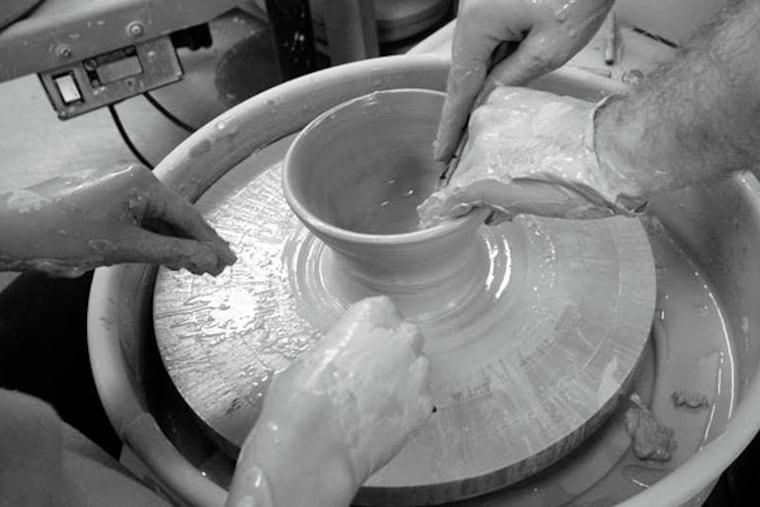Outsider art with a sense of belonging
Once, when I was 8 or maybe 9, I drew a butterfly. Its wings were symmetrical, more or less. Its colors were just this side of natural. Its antennae bore a clever curve. On that day I was an artist.

Once, when I was 8 or maybe 9, I drew a butterfly. Its wings were symmetrical, more or less. Its colors were just this side of natural. Its antennae bore a clever curve. On that day I was an artist.
Artist. What rapturous possibilities, what secret skills and power. In all my years post-butterfly, I've never again attained such glory. My middle school dioramas were sturdily glued. My poster of deep-sea creatures had a few nice hues. My beaded jewelry was primarily obsessive. I couldn't draw a thing.
Over a long stretch of my long life, I've circled that kind of art, lived it in the proximate. Gone to the museums, navigated the fringe, worked for the architects, novelized artists, married a man who kept linseed oil in the pantry by the fridge. Art (that kind of art) was something I observed. And then my husband bought us time at the Wayne Art Center.
I thought he was kidding.
He swore he was not.
For the last year, then, once most weeks, I've been taking lessons in clay, which is to say pinched pots, fab slabs, slumped humps, slipped scores, darting and seaming. I stand among persons of talent (that artist husband included) with my poundage of stoneware, and try. I dig, from my tote, the knives, the loops, the rasp, the kidneys, the pretty little pots of underglaze. I slice. I roll. I cut. I smash. I wedge the clay, start over.
The math of making pots frankly escapes me. The mysteries of slip and wax resist are deep and many. The language of muck is viscous. There are plenty of ways to ruin clay.
I ruin. I persevere.
Nested between a nature trail and the heart of Main Line Wayne, 84 years old and ever inventive, the Wayne Art Center has the hint of the palatial about it. It has many doors and many windows, rooms for making and rooms for seeing, a supersize kitchen and a lobby so capacious people can sit at tall tables, head for the gift shop, or haul in their easels, glassware, or yarn, and never feel crowded or pressed. Art takes time. Art seeks space. The center specializes in both. Through a series of considered expansions, it has maintained the fervor of its original founder, Quita Brodhead, a renowned artist whose work can be found at the Philadelphia Museum of Art and elsewhere, who was called "quite simply a phenomenon" by the New York Times, and who began offering art instruction to children in a carriage-house garage on Louella Avenue in 1930.
The center, which caters to about 5,000 kid, teen, and adult students, as well as an estimated 20,000 visitors each year, provides instruction in fine arts, crafts, the art of the kitchen, music, and drama. It offers juried exhibitions and gallery shows, team-building exercises and lectures, programs for the underserved. It yields still lives, clay frogs, book art, stained glass, plein air, international flavors, wax casts, bangles, glass forms, raku, a little theater.
In the pottery studio, where I spend three hours each week, the center also yields a rare form of community. People with skills advising people (that would be only me) without them. Encouragement hummed, sometimes even sang. Celebrations of the immortal kind. Homemade cookies, salads, breads, dandelion wine. An extraordinary quantity of laughter. Lessons in what we like to call "our social skills."
Have some.
Try this.
See what you think.
You're kidding.
Over the spinning of wheels, the rasping of clay, the stirring of glazes with toilet-bowl brushes, there is talk. Of books, cinema, Brooklyn. Of Gordon Lightfoot and Berlin. Of advertising careers and Star Wars heroes. Of recipes and garden seeds and bagpipes. Pots are getting built, tiles are being tested, faces are being carved into greenware towers. Someone offers up fistfuls of hand-colored clay. Another extols the wonders of Shino. Someone suggests that more is more, and that the accidental must be honored, and then E. will walk in with a new pair of painted sneakers, and the talk will turn to her impeccable style. We fans of E. (we are all fans of E.) adore her style.
There (and not on the periphery) I stand. Wedging, rounding, mounding, slicing, mitering, giving the clay room to do its thing. I am laughing. I am listening. Because the thing I've learned best throughout these seasons of clay is that I don't have to be excellently good at this to enjoy it. I can start at 9:30 and leave at 12:30 and not have accomplished a darned clay thing, and yet the hours will have value - tangible if not precisely quantifiable. I will leave the center feeling a little more free, a little less stressed, a little less dutiful and proper.
I will know myself to be the outsider who has found her way in. So many doors, I will think, as we drive off. So many windows.